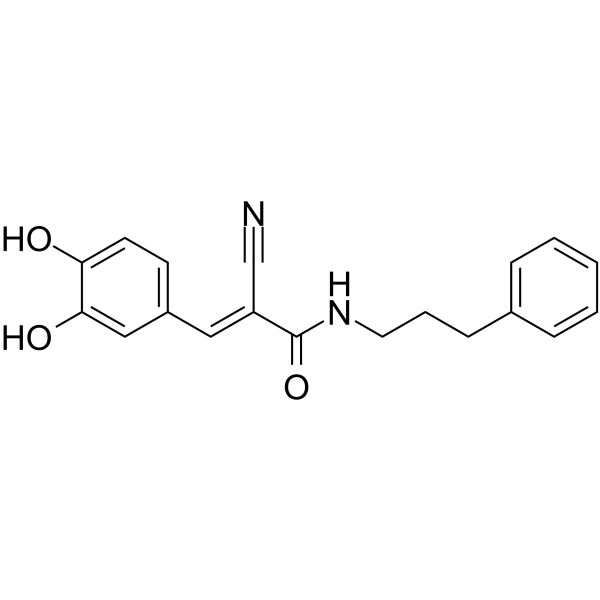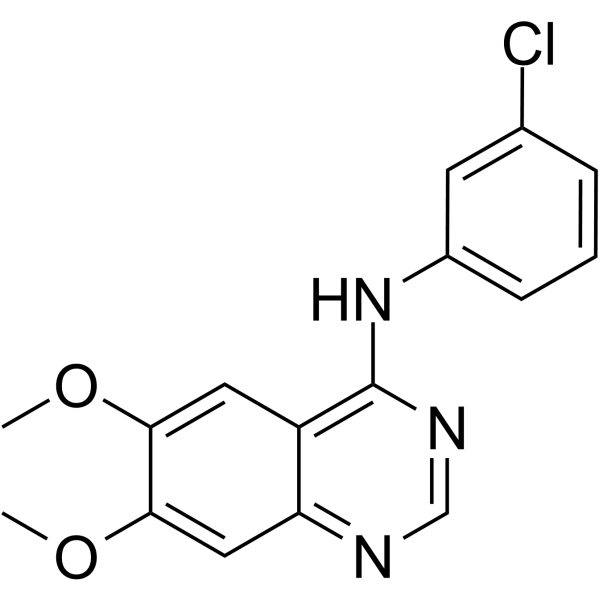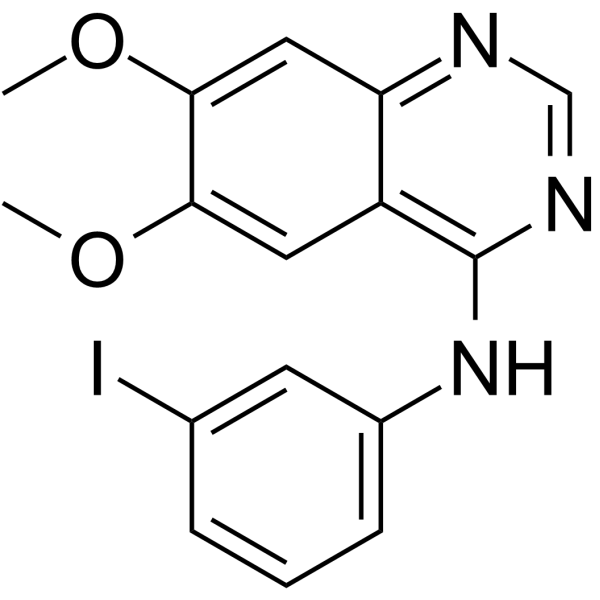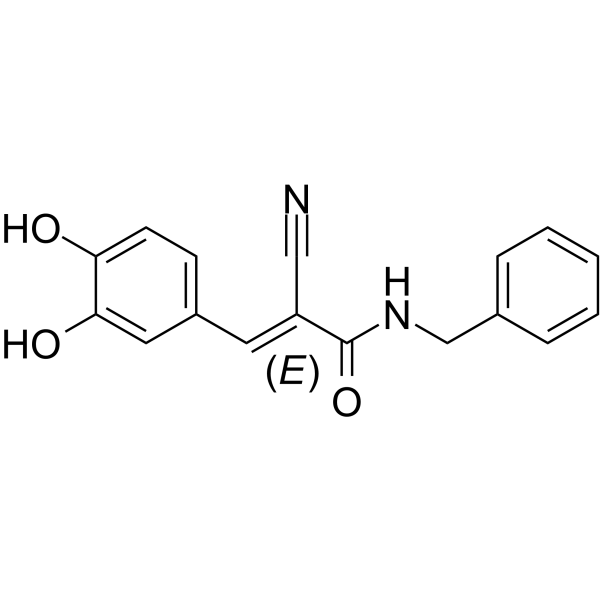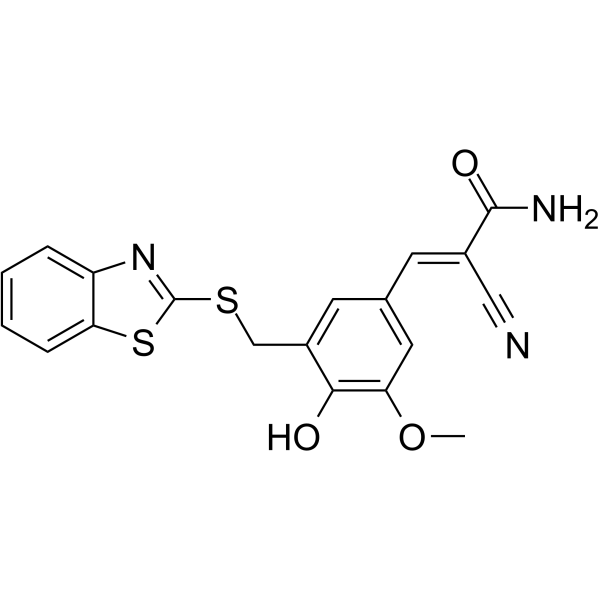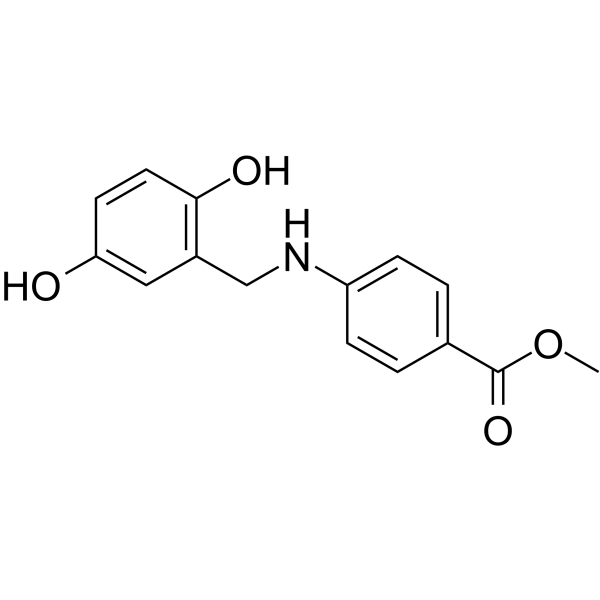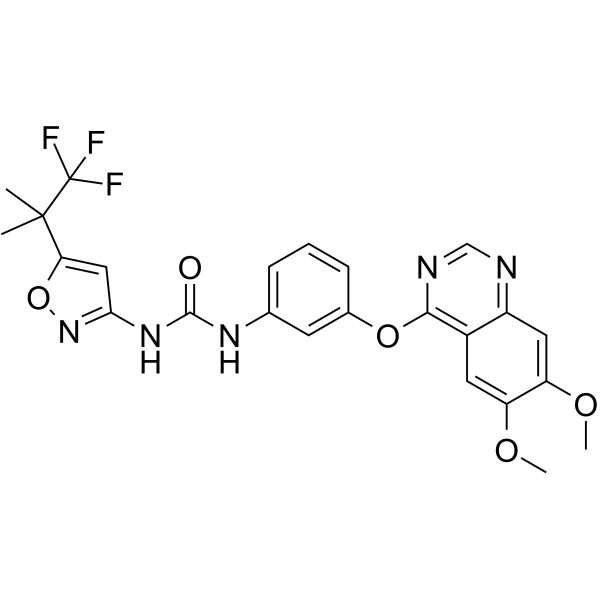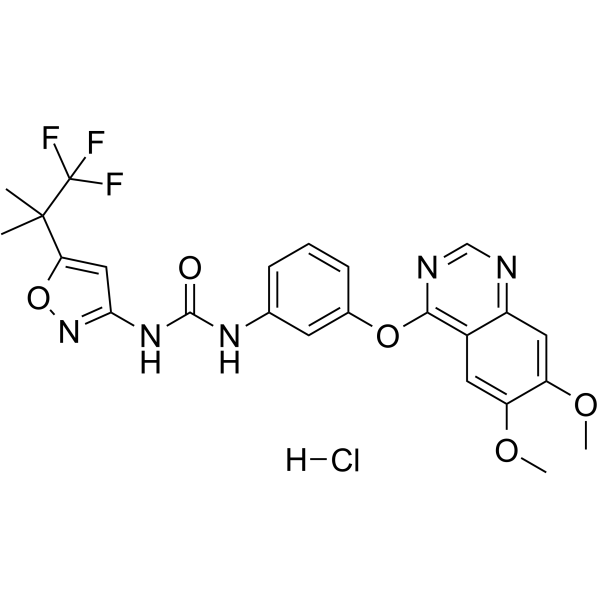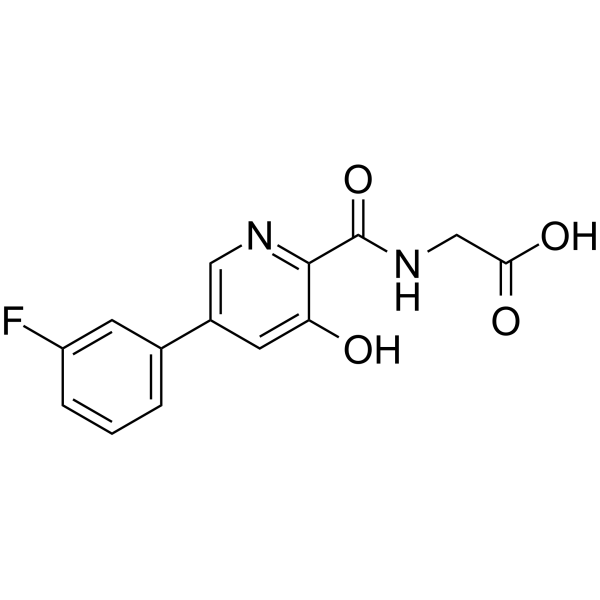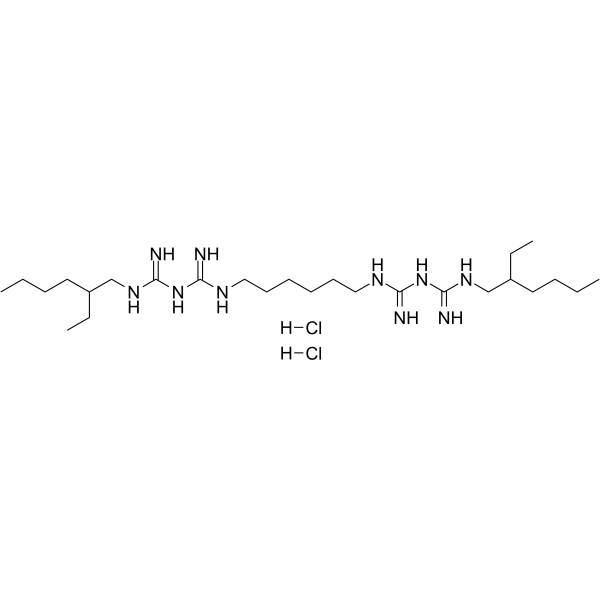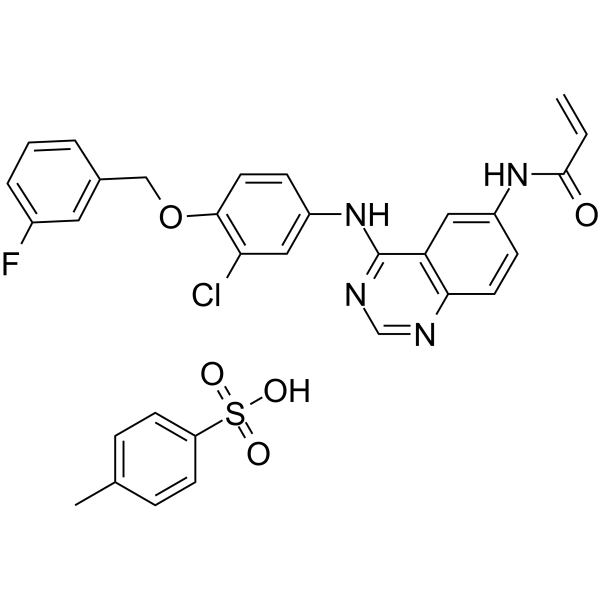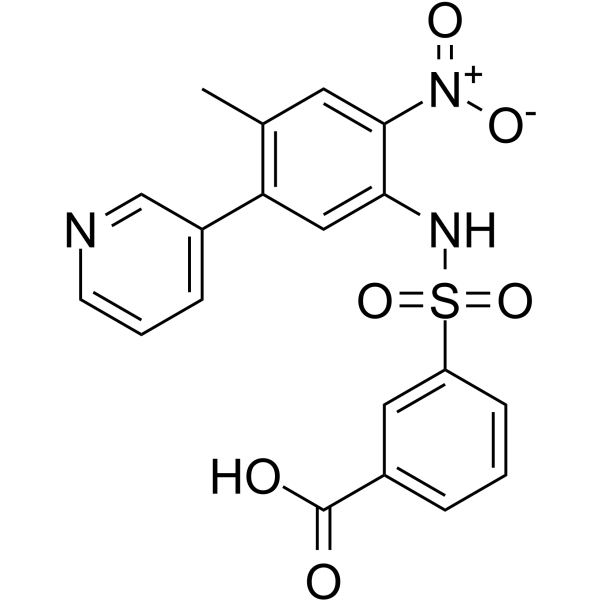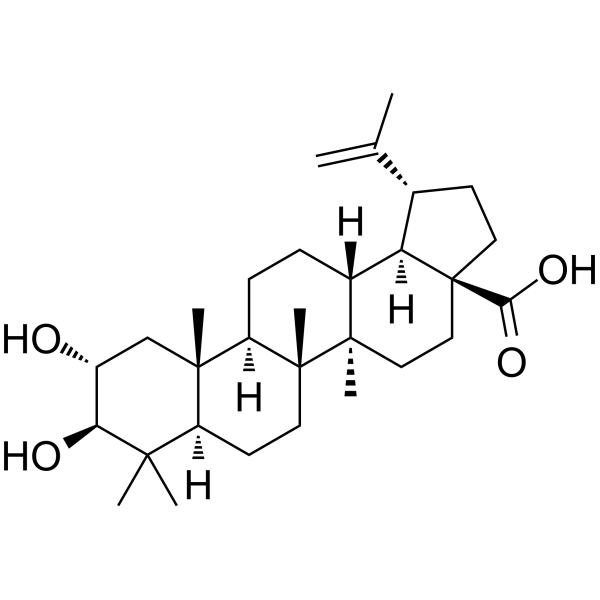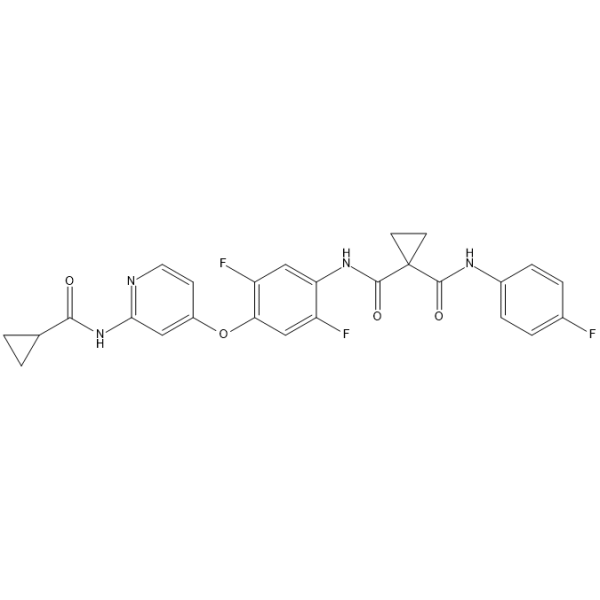|
BP10381
|
AG 555
|
|
|
|
|
AG 555 is an EGFR tyrosine kinase inhibitor.
|
|
BP10626
|
AG-1478
|
|
|
|
|
AG-1478 (Tyrphostin AG-1478) is a selective EGFR inhibitor.
|
|
BP10862
|
AG1557
|
|
|
|
|
AG-1557 is an inhibitor of the epidermal growth factor receptor (EGFR) tyrosine kinase (pIC50: 8.194).
|
|
BP10380
|
AG490
|
|
|
|
|
AG-490 (Tyrphostin AG 490) is an inhibitor of EGFR (IC50: 0.1 μM). It is 135-fold more selective for EGFR than ErbB2, also inhibits JAK2 with no effect to Lyn, Lck, Syk, Btk, and Src.
|
|
BP10591
|
AG-825
|
|
|
|
|
AG-825(Tyrphostin AG-825) is a potential agent for overcoming Mn-induced neurotoxicity or AD development and is a selective and ATP-competitive ErbB2 inhibitor which suppresses tyrosine phosphorylation, with an IC50 of 0.35 μM. AG825 significantly accelerates apoptosis of human neutrophils. AG-825 displays anti-cancer activity.
|
|
BP10477
|
AG957
|
|
|
|
|
Tyrphostin AG957, a tyrosine kinase inhibitor with anti-BCR/ABL tyrosine kinase activity restores beta1 integrin-mediated adhesion and inhibitory signaling in chronic myelogenous leukemia hematopoietic progenitors.
|
|
BP10213
|
Agerafenib
|
|
|
|
|
CEP-32496 is a highly potent inhibitor of BRAF.
|
|
BP10262
|
Agerafenib hydrochloride
|
|
|
|
|
Agerafenib hydrochloride is a highly potent inhibitor of BRAFV600E (Kd: 14 nM).
|
|
BP10011
|
AKB-6899
|
|
|
|
|
AKB-6899 is an inhibitor of prolyl hydroxylase domain 3 (PHD3) and increases the soluble form of the VEGF receptor (sVEGFR-1) production from GM-CSF-treated macrophages. AKB-6899 leads to stabilization of HIF-2α which induces sVEGFR-1 production from tumor-associated macrophages and decreases tumor growth.
|
|
BP10303
|
Alectinib Hydrochloride
|
|
|
|
|
Alectinib Hydrochloride (CH5424802 Hydrochloride; RO5424802 Hydrochloride; AF-802 Hydrochloride) is a potent, selective, and orally available ALK inhibitor with an IC50 of 1.9 nM and a Kd value of 2.4 nM (in an ATP-competitive manner), and also inhibits ALK F1174L and ALK R1275Q with IC50s of 1 nM and 3.5 nM, respectively. Alectinib demonstrates effective central nervous system (CNS) penetration.
|
|
BP10302
|
Alectinib
|
|
|
|
|
Alectinib (CH5424802) is a potent, selective, and orally available ALK inhibitor with an IC50 of 1.9 nM and a Kd value of 2.4 nM (in an ATP-competitive manner), and also inhibits ALK F1174L and ALK R1275Q with IC50s of 1 nM and 3.5 nM, respectively. Alectinib demonstrates effective central nervous system (CNS) penetration.
|
|
BP10753
|
Alexidine dihydrochloride
|
|
|
|
|
Alexidine dihydrochloride is an anticancer agent that targets a mitochondrial tyrosine phosphatase, PTPMT1, in mammalian cells and causes mitochondrial apoptosis. Alexidine dihydrochloride has antifungal and antibiofilm activity against a diverse range of fungal pathogens.
|
|
BP10852
|
Alflutinib
|
|
|
|
|
Alflutinib is a potent inhibitor of EGFR. Alflutinib inhibits EGFR active mutations as well as the T790M acquired resistant mutation. Alflutinib has the potential for the research of cancer diseases, especially non-small cell lung cancer (NSCLC).
|
|
BP10045
|
Alisertib
|
|
|
|
|
Alisertib (MLN8237) is a specific Aurora A inhibitor (IC50: 1.2 nM). The selectivity of Alisertib is >200-fold higher for Aurora A than Aurora B.
|
|
BP10224
|
ALK-IN-1
|
|
|
|
|
ALK-IN-1 (Brigatinib analog) is a potent and selective active inhibitor of anaplastic lymphoma kinase(ALK), Patent US20140066406 A1.
|
|
BP10083
|
Allitinib tosylate
|
|
|
|
|
AST-1306 is a novel irreversible inhibitor of EGFR and ErbB2 with IC50 of 0.5 nM and 3 nM, respectively.
|
|
BP10866
|
Almonertinib
|
|
|
|
|
Almonertinib (HS-10296) is an orally available, irreversible, third-generation EGFR tyrosine kinase inhibitor with high selectivity for EGFR-sensitizing and T790M resistance mutations. Almonertinib shows great inhibitory activity against T790M, T790M/L858R and T790M/Del19 (IC50: 0.37, 0.29 and 0.21 nM, respectively), and is less effective against wild type (3.39 nM). Almonertinib is used for the research of the non-small cell lung cancer.
|
|
BP10674
|
Alofanib
|
|
|
|
|
Alofanib is a selective allosteric inhibitor of FGFR2 and has a dramatic inhibitory effect on FGF2-induced phosphorylation of FRS2a in KATO III cells (IC50 <10 nM). It has no direct effect on FGF2-dependent FGFR1 and FGFR3 phosphorylation levels in either cell lines and no effects on FGF2-FGFR2 binding.
|
|
BP10900
|
Alphitolic acid
|
|
|
|
|
Alphitolic acid is a potent Hh/GLI signaling inhibitor, it shows an important relationship between Hh/GLI signaling inhibition, the decrease of BCL2, and cytotoxicity against cancer cells.
|
|
BP10398
|
Altiratinib
|
|
|
|
|
Altiratinib(DCC-2701) is a novel c-MET/TIE-2/VEGFR inhibitor; effectively reduce tumor burden in vivo and block c-MET pTyr(1349)-mediated signaling, cell growth and migration as compared with an HGF antagonist in vitro.
|
